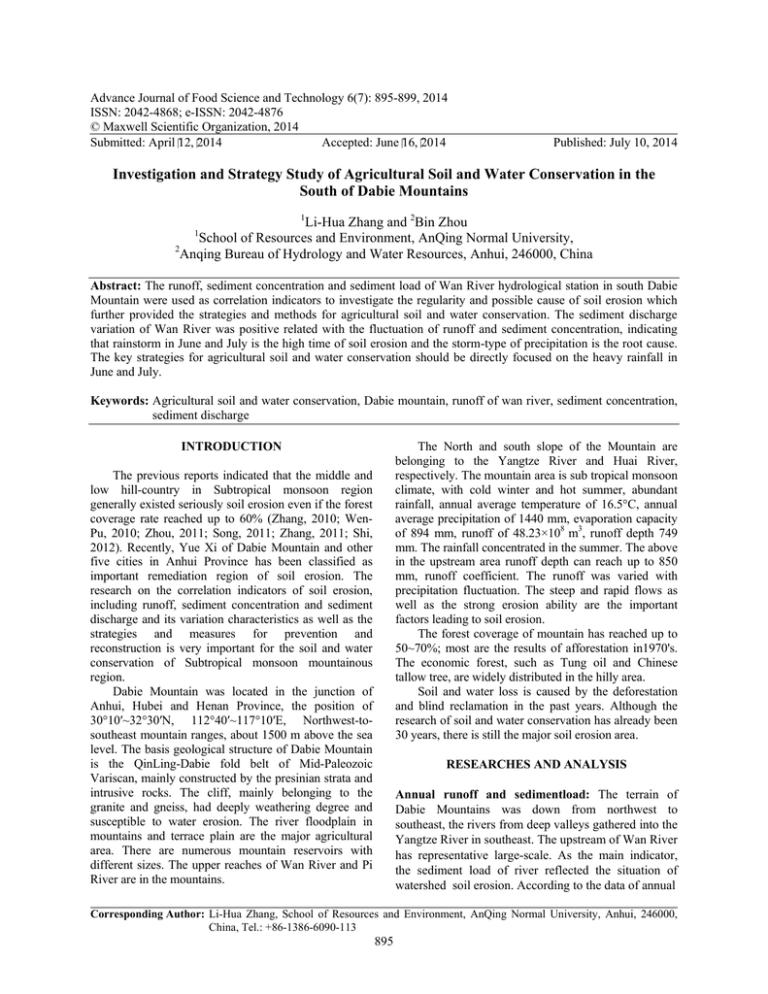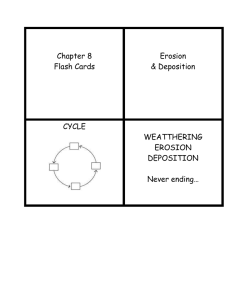Advance Journal of Food Science and Technology 6(7): 895-899, 2014
advertisement

Advance Journal of Food Science and Technology 6(7): 895-899, 2014 ISSN: 2042-4868; e-ISSN: 2042-4876 © Maxwell Scientific Organization, 2014 Submitted: April 12, 2014 Accepted: June 16, 2014 Published: July 10, 2014 Investigation and Strategy Study of Agricultural Soil and Water Conservation in the South of Dabie Mountains 1 Li-Hua Zhang and 2Bin Zhou 1 School of Resources and Environment, AnQing Normal University, 2 Anqing Bureau of Hydrology and Water Resources, Anhui, 246000, China Abstract: The runoff, sediment concentration and sediment load of Wan River hydrological station in south Dabie Mountain were used as correlation indicators to investigate the regularity and possible cause of soil erosion which further provided the strategies and methods for agricultural soil and water conservation. The sediment discharge variation of Wan River was positive related with the fluctuation of runoff and sediment concentration, indicating that rainstorm in June and July is the high time of soil erosion and the storm-type of precipitation is the root cause. The key strategies for agricultural soil and water conservation should be directly focused on the heavy rainfall in June and July. Keywords: Agricultural soil and water conservation, Dabie mountain, runoff of wan river, sediment concentration, sediment discharge The North and south slope of the Mountain are belonging to the Yangtze River and Huai River, respectively. The mountain area is sub tropical monsoon climate, with cold winter and hot summer, abundant rainfall, annual average temperature of 16.5°C, annual average precipitation of 1440 mm, evaporation capacity of 894 mm, runoff of 48.23×108 m3, runoff depth 749 mm. The rainfall concentrated in the summer. The above in the upstream area runoff depth can reach up to 850 mm, runoff coefficient. The runoff was varied with precipitation fluctuation. The steep and rapid flows as well as the strong erosion ability are the important factors leading to soil erosion. The forest coverage of mountain has reached up to 50~70%; most are the results of afforestation in1970's. The economic forest, such as Tung oil and Chinese tallow tree, are widely distributed in the hilly area. Soil and water loss is caused by the deforestation and blind reclamation in the past years. Although the research of soil and water conservation has already been 30 years, there is still the major soil erosion area. INTRODUCTION The previous reports indicated that the middle and low hill-country in Subtropical monsoon region generally existed seriously soil erosion even if the forest coverage rate reached up to 60% (Zhang, 2010; WenPu, 2010; Zhou, 2011; Song, 2011; Zhang, 2011; Shi, 2012). Recently, Yue Xi of Dabie Mountain and other five cities in Anhui Province has been classified as important remediation region of soil erosion. The research on the correlation indicators of soil erosion, including runoff, sediment concentration and sediment discharge and its variation characteristics as well as the strategies and measures for prevention and reconstruction is very important for the soil and water conservation of Subtropical monsoon mountainous region. Dabie Mountain was located in the junction of Anhui, Hubei and Henan Province, the position of 30°10′~32°30′N, 112°40′~117°10′E, Northwest-tosoutheast mountain ranges, about 1500 m above the sea level. The basis geological structure of Dabie Mountain is the QinLing-Dabie fold belt of Mid-Paleozoic Variscan, mainly constructed by the presinian strata and intrusive rocks. The cliff, mainly belonging to the granite and gneiss, had deeply weathering degree and susceptible to water erosion. The river floodplain in mountains and terrace plain are the major agricultural area. There are numerous mountain reservoirs with different sizes. The upper reaches of Wan River and Pi River are in the mountains. RESEARCHES AND ANALYSIS Annual runoff and sedimentload: The terrain of Dabie Mountains was down from northwest to southeast, the rivers from deep valleys gathered into the Yangtze River in southeast. The upstream of Wan River has representative large-scale. As the main indicator, the sediment load of river reflected the situation of watershed soil erosion. According to the data of annual Corresponding Author: Li-Hua Zhang, School of Resources and Environment, AnQing Normal University, Anhui, 246000, China, Tel.: +86-1386-6090-113 895 Adv. J. Food Sci. Technol., 6(7): 895-899, 2014 Fig. 1: The data of annual runoff and annual sediment load annual runoff and annual sediment load for the years from 1965 to 2010 gathered by Wan River Shipai hydrological station Fig. 2: The average annual runoff and sediment concentration of the year 1965~2010 in Wan River average annual sediment load of 46 years is 55.28×104 t/year. The variation of annual sediment load can be regarded as two different parts. Before 1997, the annual sediment load is considerable; from 1997 to 2010, the sediment load significantly decreased, meaning the situation of soil erosion has been altered and became better. The improvement is related with the large-scale afforestation and the increased forest coverage after 1970’s. After 20 years of accumulation, until 1997, the contribution of forests to water and soil conservation began to emerge. runoff and annual sediment load for the years from 1965 to 2010 which gathered by the Shipai hydrological station, the results were shown in Fig. 1. River runoff (Q) and sediment load (V) is a linear relationship, V = QS, where S is the sediment concentration. According to Fig. 1, the curve indicated that is not a simple linear relationship between the annual runoff and sediment load, suggesting that the sediment concentration (S) is unstable. The calculated Pearson product-moment correlation coefficient for the annual runoff and annual sediment load of the years from 1965 to 2010 is 0.687 which stayed in low level. That might cause by the varied annual rainfall or rainfall intensity which further lead to the greater change of sediment concentration. As shown in Fig. 1, the annual sediment load of 1965~2010 presented a clearly downward trend. The Correlation between the annual runoff and sediment concentration: As shown in Fig. 2, from 1965 to 2010, the average annual runoff of Wan River was 33.2×108 m3. In most years, the annual runoff varied between the ranges of 20×108~50×108 m3. It has been flood years or 896 Adv. J. Food Sci. Technol., 6(7): 895-899, 2014 dry years while the values of annual runoff out of the range, such as the year of 1969, 1978 and 1983. The curve of annual runoff in Fig. 2 showed positive correlation with the annual average sediment concentration, in which the significant correlation appeared before 1980s and between dry years and flood years. The Pearson product-moment correlation coefficient for that of the year of 1965 to 2010 was calculated to be 0.291. In fact, there is no causal link between the average annual runoff and sediment concentration. In the year of large annual runoff or flood year, the intense precipitation and the floods caused strong erosion and increased sediment concentration; in normal year without strong precipitation, the two didn’t show correlation; in the dry year, little precipitation and weak erosion lead to the decreased annual sediment concentration. The changes of annual average sediment concentration can be divided into two stages. From 1965 to 1997, the variation range for the most years is about 0.18~0.32 kg/m3; the maximum value appeared in the flood year while the minimum appeared in the dry years, such as the year of 1969 and 1978. From 1997 to 2010, the fluctuation range of average sediment concentration significantly decreased, basically beyond the value of 0.18 kg/m3, indicated the decline of soil erosion, consistent with characteristics of the sediment load variation. The correlation coefficient of Pearson product-moment for average annual sediment concentration and sediment load from 1965 to 2010 was calculated to be 0.825 with significant correlations. Based on the analysis, it can be proposed that in the year of large runoff and precipitation, the average annual sediment concentration and annual sediment transport also greatly increased. In the years of 1969, 1978 and 1893, the annual precipitation and the sediment concentration showed great differences, both of them appeared simultaneously peaks and valleys. According to the data in Fig. 2, the annual runoff and annual sediment load were calculated to be (61.98×108m3, 289.9×104 t) and (11.3×108m3, 12.4×104 t) for the year of 1969 and 1978, respectively. Compare the values of the two years; there were 4.5-fold difference in annual runoff and 22.3-fold difference in sediment load, reflecting that there much more soil erosion in flood years than that of dry years. (a) (b) Fig. 3: The average runoff and sediment concentration for dry years and wet years of Wan River Shipai station times of the minimum monthly runoff (February, 13.9 m3/s). Sediment concentration of July is 0.24 kg/m3. The smallest value is 0 (August to December, January and February). The Pearson product-moment correlation coefficient of monthly average runoff and monthly average sediment is 0.785, showed a significant positive correlation. The annual runoff of dry year and sediment concentration also reflected these characteristics. The year of 1978 is a typical dry year which runoff concentrated in the first half and monthly runoff reached the maximum in May and June, but still lower than 100 m3/s. The monthly runoffs as well as sediment concentration for the months of July to December are very small. The Pearson product-moment correlation coefficient of monthly average runoff and average sediment concentration was 0.658, also showed a significant positive correlation. Thus, positive correlation between the monthly average runoff and sediment concentration is more significant. That indicated the month with large precipitation intensity has higher sediment Positive relationship between the average monthly runoff and sediment concentration: The summer monsoon precipitation has great influence on the monthly average runoff of Monsoon River. As shown in Fig. 3, the variation of monthly average sediment was significantly positive related with the fluctuations of monthly runoff in Shipai hydrological station. The runoff of 1996 (wet year) is 54.44×108 m3, concentrated in June and July. Monthly runoff of July showed maximum value of 1250 m3/s, equivalent to 90 897 Adv. J. Food Sci. Technol., 6(7): 895-899, 2014 Table 1: Soil erosion distribution area in Wan River basin* Moderate soil erosion -----------------------------------Total area of soil and District Area (km2) water loss (km2) Area (km2) Area ratio/% Total 3516 1276 631 45.1 The upper reaches of Chang River 2023 798 338 42.4 The upper reaches of Wan River 485 158 95 60.1 The upper reaches of Qian River 1008 320 198 62.1 *The statistic data of river basin planning was collected by Anqing Water Conservancy Bureau in 2005 Typical villages Dianqian, Beizhong, Niuzhen Longtan, Yujing, Maojian Hill Changpu, Shuihou, Gedu concentration, the sediment load concentrated in the rainy months of June and July which presented a large number of soil erosion. is very limited. The economic forest coverage in the southern slope of Dabie Mountains is about 30 to 70%. More than 80% area of hillside land is terraced. Field investigations: Typical dry soil erosion area in the upstream of Wan River and diving basin were investigated and the profile of soil erosion was shown in Table 1. The area of Dabie Mountains is one of the storm center at the junction of Yangtze River. The precipitation concentrated in May to September. The average number of heavy rainfall per year was 5.2 times, the rainstorm happened in June and July is 81.9% of the whole year. For years, the average rainfall of 24 h in river basin is 125 mm. The rainstorm is highly consistent with the floods. Generally, the rainstorm duration is about 1~2 days which the longest could up to 3~5 days and the shortest only cost few hours. That also suggested the sharply fluctuations of floods, strong scouring forces and large sediment concentrations as well as the huge destructive forces in very short time. Generally, the hillside slope of soil erosion area is about 30°~40°, the steepest slope is up to 70°. The bottom of the valley is exposed bedrock and the crumbled and landslide regolith can be observed in the riverside. The floods spread fast and most tributaries of the river present single peak which the flood duration is generally 1~3 days. According to Table 1, water erosion is the main reason that areas caused the soil erosion in the key areas, at the same time, there still existed gravity erosion and mixed erosion in steep ravine and valleys. The erosion was mainly taken out by surface erosion, but also had gully erosion. Surface erosion was appeared with agriculture, forestry, land clearing, mining and other human activities. It has large amount of erosion which is difficult to observation and has great potential hazards. Rill erosion is the main form of surface erosion in the cropland with thicker soil layer. Gully erosion has the characteristics of concentration, sporadic and high degree of observation. Floods landslides, avalanches and mudslides often accompanied by the heavy rainstorm. The existing forest in the area of Dabie Mountains is mainly coniferous forest, mostly is single pure forest. Due to unitary species, the forest ecosystem stability is not high, the ability of conserve water and block runoff CONCLUSION In summary, the afforestation in the area of Dabie mountains which started from the 1970s increased forest coverage and significantly improved the soil erosion. However, the area of mountains which already relatively higher forest coverage still exist water and soil erosion. Average annual runoff of Wan River was positively correlated with sediment concentration, so was the monthly average runoff. These results indicated the rainstorm precipitation is the root cause of soil erosion. In addition, Steep slopes, deep valleys and strongly weathered rock are also important factors. It also showed that heavy rainfall from June to July is the high incidence period of soil erosion, sediment transport capacity, especially in wet years. The survey also confirmed by the analysis of field investigation. According to the research, the strategies and measures should be directly against the strong precipitation in June and July and continue the work of soil and water conservation on the existing base. Adjust the industrial structure and farmland farming systems: The traditional farming of Dabie Mountain is two cropping system. After the summer harvest, most of the farmland was bared. Plowing and tillage will lead to the loss of surface protection which is very sensitive to heavy precipitation. To this problem, the possible method is abandoning the traditional double cropping cultivation, expanding specialty crop rotation in mountain area and adjusting the industrial structure and farming systems, ensuring the coverage of farmland in June and July to against soil erosion that caused by the storms and overland sheet flow. Limiting the excavated construction in storm-prone period: Spoil heap project involves the construction and land mining is one of the important causes of soil erosion. Terracing formed high and steep slope, spoil improper handling can cause serious soil erosion. Concentrated in construction or mining quarrying town area, construction area of road construction, soil erosion are the focus areas. Recommended for large projects 898 Adv. J. Food Sci. Technol., 6(7): 895-899, 2014 must be designed before construction of water conservation measures; prohibit mining of construction between June and July. ACKNOWLEDGMENT This study is financial supported by Anhui Province Natural Science Fund Project 07021011. The author is grateful for providing the statistic data by Hydrology and Water Resources Bureau of AnQing. Construction of soil and water conservation project: Protection works usually have terraced hillside, horizontal grooves and horizontal bands. The retaining wall was usually constructed in cliffs and deep valleys. The water resources of main rivers should be integrate developed to ensure flood control and runoff stability, reduce the riverbed erosion and mudslides incidence. REFERENCES Shi, Z.G., 2012. Characteristics and comprehensive investigation of soil erosion in Dabie mountains in the west of Anhui province. Res. Soil Water Conserv., 19(5): 39-42. Song, J., 2011. Studies on clean and ecological-friendly small watershed management model in earth-rock mountainous regions. China Water Resour., 16: 54-58. Wen-Pu, Z., 2010. The comprehensive treatment and benefit analysis of WuGuan watershed. Bull. Soil Water Conserv., 30(1): 95-198. Zhang, L.H., 2010. Resources and Environment of Anhui. Press of HeFei University of Technology, Hehui. Zhang, X.Y., 2011. Model research on integrated management of water and soil conservation of small watershed. China Water Resour., 12: 58-61. Zhou, F., 2011. Practice and consideration on comprehensive governance of east river watershed. Soil Water Conserv. China, 2: 52-53. Improve the forest structure: When the forest coverage rate reached up to 65%, it’s unrealistic to further increase forest coverage rate. Thus there are two ways to the work of soil and water conservation: one is to improve forest structure, add the species of native trees and broadleaf to improve canopy density and change the single status of coniferous forest; another is to improve vegetation structure, recover the understory shrubs and herbaceous vegetation. Protecting the grass of economic landscape: The economic landscape, such as Mulberry, tea and fruit as well as herbs, is the most commonly operation mode with good prospects for expansion in the mountain area. Currently, the coverage of understory herbaceous generally stay in low level, the planting way of garden mostly similar to that of farmland, the garden work must be adjusted to prohibit bare ground from June to July and to block surface runoff. 899



